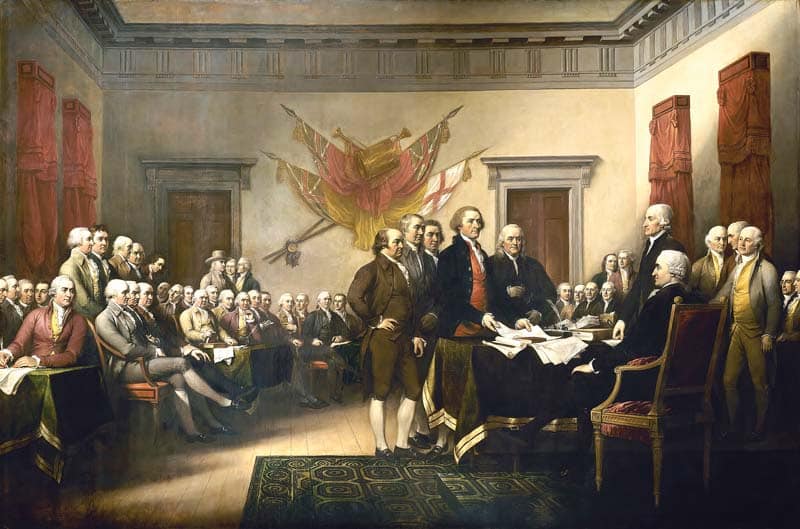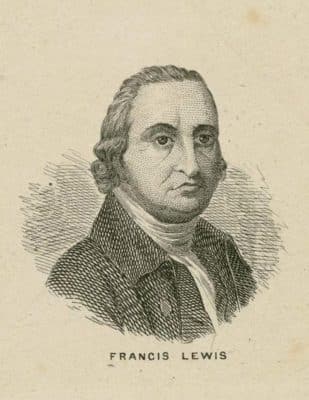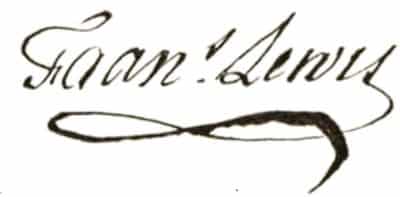
Of the New Yorkers involved in the nation’s founding, Alexander Hamilton is the one best known to the public. Francis Lewis (1713-1802) was a New Yorker who suffered greatly for the cause of American independence. His family suffered, too. Indeed, an entire book could be written on his son, Morgan, who was governor of New York from 1804 to 1807 and who served as a major in the United States Army during the Revolutionary War and as a major general in the War of 1812. A grandson, Manny, died during the epic, three-day Battle of Gettysburg.
Francis Lewis was the only son of a Welsh clergyman. By the time he was 5 years old, both of his parents had died. It was the beginning of a life filled with such heartache. But it was also the beginning of a life filled with monumental achievements. Lewis was raised by relatives and attended London’s prestigious Westminster School. At age 21, Lewis also came into a generous inheritance. He sailed off to the North American colonies, getting involved in several business ventures. When the French and Indian War broke out in 1754, Lewis was head of a manufacturing firm that made clothing for British troops. The man was no summer soldier. While in battle at Fort Oswego in Upstate New York, Lewis was captured by French forces. The French, in turn, handed Lewis and other prisoners to their Native American allies. Either death or captivity awaited the man. Miraculously, Lewis survived. His knowledge of the Welsh language helped him to understand the language of his captors, whose chief was so impressed that he released Lewis to the custody of his family in Montreal. For his loyalty, Lewis, after the war, was awarded 5,000 acres of land on Long Island from the British Crown. That includes the streets and roads that countless New Yorkers drive or walk or bike on every day.
Lewis eventually purchased an estate in Whitestone, Queens. With the Stamp Act, however, Lewis turned on the Crown. He was active in the push for independence, attending both the First and Second Continental Congresses and serving as a member of The Sons of Liberty. Benjamin Rush hailed Lewis as “a very honest man and very useful in executive business.”
When independence was declared and war came, the British initially held the upper hand in the conflict. After routing the Colonials in the Battle of Brooklyn, British troops set their sights on the Lewis mansion. Francis Lewis and his sons were in the field, leaving Elizabeth, Lewis’s wife and mother of the couple’s seven children, to fend off the British. “Elizabeth remained calm as the soldiers advanced and a British warship opened fire on the house,” a Lewis biographer wrote. “A soldier tore the glittering buckles from her shoes that looked to him like gold but were really just pinchbeck. ‘All that glitters is not gold,’ Elizabeth remarked to the discomfited young man.” The troops proceeded to destroy books, papers, pictures and furniture. Elizabeth was captured and sent to a prison without a bed, a change of clothing and little food.

Word of her treatment eventually reached George Washington. The general promptly had his men arrest the wives of both the British Paymaster-General and the Attorney General of Pennsylvania. British authorities were told that these two women would face the same harsh treatment Elizabeth Lewis was now subject to. The threat worked. A prisoner exchange was negotiated. Elizabeth Lewis’s brief prison term took its toll. She died in June 1779 in Philadelphia with her husband by her side.
Washington was loyal to the Lewis family. Francis Lewis, in turn, returned the honor. Lewis stood by Washington when the Conway Cabal plotted to have the general replaced as commander of the Continental Army with General Horatio Gates. As the war was winding down, Lewis signed the Articles of Confederation, a document that kept the 13 colonies together while the U.S. Constitution was being drafted, debated on and ratified. Lewis was one of the 16 men to sign both the Declaration and the Articles.
After a lifetime of trials, tribulations, heartache and historic triumphs, Lewis retired to his home in lower Manhattan. He served as a vestryman at the Trinity Church, one of the city’s oldest Episcopal churches. Lewis died in 1802 and was buried in an unmarked grave at Trinity’s cemetery. Even though he lost his wife and his Whitestone home during the war, Lewis was comforted in his retirement by his children and grandchildren. They, too, would live eventful lives.
Morgan Lewis was, as noted, both a governor of New York and an officer in the U.S. Army. His accomplishments were as monumental as his father’s. During the Revolutionary War, Morgan Lewis rose to the rank of major and quartermaster-general, playing a key role in the American victory at Saratoga. As the country went to war in 1812, President James Madison offered Morgan the position of Secretary of War. Morgan turned that down, preferring instead to serve, once again, on the front lines. Morgan was now a major general in the army. He captured Fort George and commanded the successful campaigns at Sackett’s Harbor and French Creek. Francis Lewis would have been proud of his son.
 He, too, would have been proud of his grandson. Morgan Lewis married Gertrude Livingston, daughter of Robert Livingston, a prominent colonial American politician and a leading Whig in New York in the years leading up to the American Revolution. Morgan and Gertrude’s son, Manny completed the circle of the Lewis family’s exemplary service to the young nation. Manny, as noted, died at Gettysburg, the 1863 battle that turned the tide of the Civil War in the Union’s favor.
He, too, would have been proud of his grandson. Morgan Lewis married Gertrude Livingston, daughter of Robert Livingston, a prominent colonial American politician and a leading Whig in New York in the years leading up to the American Revolution. Morgan and Gertrude’s son, Manny completed the circle of the Lewis family’s exemplary service to the young nation. Manny, as noted, died at Gettysburg, the 1863 battle that turned the tide of the Civil War in the Union’s favor.
Francis Lewis is not forgotten. There is a Francis Lewis Boulevard in northern Queens, a high school and park named for him, plus a plaque outside the site of his former Whitestone estate. In Washington, Lewis’s name is on a memorial that sits near the Washington Monument and he figures prominently in an Andrew Turnbull painting on Capitol Hill.
Lewis is not remembered as he should be, either. In 2011, Whitestone residents, along with a descendant of the Lewis family, expressed a desire to have a statue erected to the man. Such people might want to contact the local Daughters of American Revolution (DAR) chapter and consider raising the funds to build statue on private property. There are 51 members of the New York City Council and I doubt that any of them know or care who Lewis was, not to mention who his son was. The mayor of New York City probably doesn’t know who Lewis is, nor might the governor of New York, even though the latter is a native of Queens County.
The Lewis family suffered greatly for the cause of the young nation. They even paid with their lives.


















